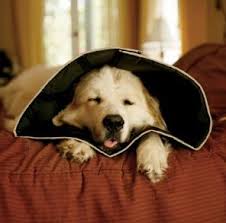As a Registered Veterinary Technician, it is often our responsibility to review specific homecare instructions with owners when patients head home after procedures in our hospital. Emphasizing the importance of their pets’ E-collar frequently tops that list and yet often, it is the first thing that gets overlooked when they get home.
Last winter we had a young pup come into our clinic to have a small wound on her leg looked at. This sweet, healthy Wheaton Terrier required a short general anesthetic to repair and suture the site and there were no complications before, during or after the surgery. She recovered very well from her anesthesia and we sent her home with appropriate medications and strict instructions to keep the E-collar on at all times and closely monitor the incision line. Unfortunately, this patient was allowed to romp around the house without her E-collar and by the time the next morning arrived the damage was done – she had chewed out most of the stitches and the incision site was wide open, immensely inflamed, oozing, and infected. What was originally a routine procedure quickly turned into another surgery to debride, clean, place a drain, and reclose the wound. We reiterated once more the importance of the cone but she returned a couple days later having yet again, removed the stitches and opened the wound. The damage was significant enough that reclosing the surgical site was no longer an option. We had to create an elaborate bandage, the dog was put on strict cage rest, and her owner was required to bring the dog back every few days for bandage changes until the site could heal properly. A one time visit had now turned into weeks worth of appointments, re-evaluations, and procedures to repair the surgical site and encourage proper healing – a situation that could have easily been avoided with a simple solution.
In the clinic we commonly refer to them as a “cone” or an “E-collar.” You may even hear us call them a “buster collar.” To you and your pet however, it may be known as the “lampshade,” the “satellite dish,” “some medieval form of torture device” or more humorously, the “cone of shame.” But all joking aside, the cone serves a far greater, medically beneficial purpose.
The E-collar (aka Elizabethan Collar) first made its fashionable (I use that term lightly) debut on men, women and children back in mid-sixteenth and seventeenth centuries over in Western Europe.
Thankfully for you and I, this fashion trend faded with the times. That was until a gentleman by the name of Edward J. Schilling came along in the 1930’s and used the idea of the Elizabethan collar to create the first inflatable E-collar for a pet. It wasn’t until the 1950’s after creating his first plastic E-collar that the true “cone” came to form. Today you can find many styles of cones available for your pet including inflatable, plastic, or soft cone.
Rest assured we do not give your pets a cone solely as a fashion trend. Truth be told, the cone serves as a functional and economical protective medical device used to prevent your animal from further damaging a surgical incision or wound site, or creating a new one. It helps to stop them from licking or biting at their body or feet and can prevent them from scratching their head or ears or neck, allowing wounds and injuries time to heal. Without this simple protective tool, your pet could reopen surgical incision sites or create severe wounds that can quickly become inflamed and infected due to their incessant licking or biting.
We fully understand that having the cone on your pet not only seems like an annoyance to them, but also to you. We’ve all been hit from behind in the back of the knee with the cone or in the shins (ouch!) and we know the sound of it slamming into walls and corners all too well. But I guarantee we have your pet’s health and well being in the forefront of our minds. We prefer to think of it as short-term “pain” for long-term gain. The less opportunity your pet has to access and damage their surgical site or wound, the faster they heal. In fact, in our experience most pets tend to adapt to cones well – they learn to take the stairs slowly, to take the corners a little wider, and yes, most can still eat and drink with it on.
We do recognize that there are always exceptions to the rule and some animals continue to surprise us with their contortionist like moves. If this sounds like your pet, not to worry! Alternative options are case dependent but may include an inflatable neck pillow, softer paper cones, body suits, t-shirts, shorts or boxers, booties, onesies, or possibly bandages. We strongly encourage that you speak with our veterinary team about this; it’s safe to say we’ve pretty much seen it all! We would be more than happy to work with you and your pet to help find a safe, comfortable and effective alternative.




